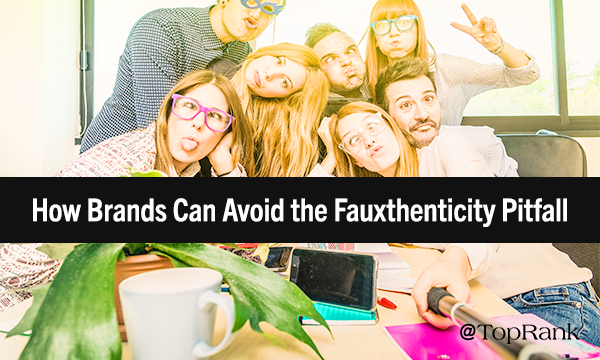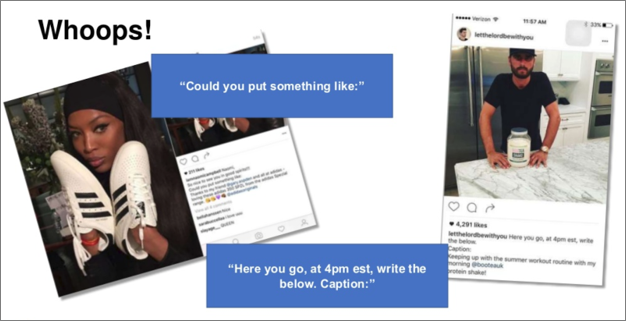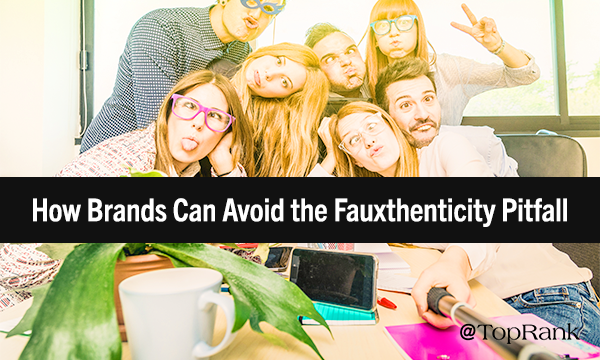
Let’s be real for a second here.
Today’s marketers and brands are collectively recognizing the need to strike a note of authenticity with their audiences. That’s excellent.
But in the quest to get real, it’s all too easy to wind up making the exact opposite impression by trying too hard, especially on social media channels.
When I think about this subject I’m always reminded of Steve Buscemi’s attempt to conform with school kids on the TV show 30 Rock:
So, we should ask ourselves: How can we, as businesses, avoid this “fauxthenticity” pitfall? How can we overcome the inherent barriers that inhibit genuine connections between brand and customer? How can we speak the language of our audience without looking like we’re trying really hard to speak their language?
It might be helpful to start out by looking at a few examples of authenticity gone awry, and dissect where things misfired with an eye on getting it right.
Can a Brand Be Your Friend?
Ian Bogost wrote a piece for the newest issue of The Atlantic entitled Brands Are Not Our Friends. Referencing an experience where the telecommunications giant sent Bogost delivery pies in response to a Twitter quip, the subhead reads: “Comcast sent me 10 pizzas. This isn’t nice; it’s manipulative.”
There’s a fine line to walk here, isn’t there? Comcast was executing a “surprise and delight” strategy, which isn’t a bad idea. But when the action rings hollow and transparent, the desired impact won’t be there.
In his story, Bogost cites another example where the social media team for Steak-umms, a seller of frozen beef, reached out to him via DM to sign a petition as part of the company’s tongue-in-cheek campaign to become verified on Twitter. When he learned that he’d been selected for inclusion by sophisticated software that analyzed his location, interests, and social media usage habits, it made him a bit uncomfortable.
The bottom line here? If you’re seeking to surprise and delight, you certainly don’t want to surprise in the wrong way.
The ultimate point of Bogost’s article is, I think, a good one. No, brands cannot be your friends. They can be friendly, but even with a real human being behind the account, they’re still intangible entities driven by commercial motivations.
But you know what? That’s OK, because there’s still a space to play.
What brands CAN strive to be is trustworthy, likable advocates with empathetic connections to their customers and prospects. And that is what our aim should be.
When it comes to achieving this distinction, I believe there are four fundamentals that must be front-and-center, which I get into below.
Fleeing Fauxthenticity: 4 Ways for Brands to Keep it Real
#1 – Know Your Audience
More or less the prime directive for content marketing in general, but in this conversation it becomes further magnified. It’s not simply about understanding general demographics, or keeping up with segmented trends, or regurgitating the terminologies and buzzwords they like to use (our Josh Nite had a great post earlier this year that opened with an ill-fated brand attempts to ride the wave of popular user hashtags).
It’s about understanding what really matters to them, and knowing them well enough to anticipate what’s going to resonate or fall flat. Dig deeper in your research. Study past campaigns by other brands or agencies with similar audiences, to see what’s worked and what’s totally missed. Have actual conversations with the people you serve or wish to serve.
At TopRank Marketing, our content team focuses extensively on gathering and analyzing audience insights before we start trying to connect or engage. Authenticity efforts guided by incomplete information or algorithm-based assumptions (like the aforementioned Steak-umms case) can instill negative feelings rather than positive ones, which is certainly not what we want.
Internet users are getting smarter these days. They see through half-baked stunts.
#2 – Don’t Be Overly Rosy
From my view, this is the absolute most pivotal element, and also the toughest to nail. No company wants to go around trashing itself, or sending off negative vibes all the time. But, then again, the world can be a difficult and upsetting place. Things don’t always go right.
The most transparently fauxthentic brands to me are those bubbly, peppy, happy-go-lucky ones that speak solely in optimism and exclamation points. People by and large cannot relate to that.
As an example, check out this recent Listerine-sponsored Instagram post from internet celeb Scarlett London, which drew massive backlash:

On his blog, Scott Guthrie wrote of this cloying attempt at influencer marketing:
“Yes, it was staged, yes it was trite. Yes it appears to feature tortillas propped on her bed masquerading as pancakes. Yes the influencer was sitting on a bedspread that sported a huge photo of herself on it.”
Suffice to say this post left a bad taste in people’s mouths. “Instagram is a ridiculous lie factory made to make us all feel inadequate,” ranted one tweet that’s been liked 111,000 times.
Yikes.
I think brands should not necessarily skew more negative, but more realistic. Acknowledge the struggles so many of us share. Mix in failures with your success stories. Confront the flaws or drawbacks of your solution head-on instead of pretending they don’t exist.
And also: Don’t be afraid to repel people who aren’t really in your wheelhouse. If your content can filter out users that aren’t fits for your business, and avoid wasting their time, that’s almost as valuable as pulling in the right people.
#3 – Infuse Influencers in Their Natural Element
The Listerine example above shows how influencer marketing can backfire when mishandled. During her session on dispelling influencer marketing lies at CMWorld 2018, TopRank Marketing’s Digital Strategy Director Ashley Zeckman cited a couple examples of similar Instagram flops, wherein the “influencer” accidentally pasted the brand’s instructions into their post captions:

The ultimate of fauxthenticity fails.
Integrating relevant influencers into marketing campaigns is a terrific way to add credibility, but only if those participants can become a genuine part of the narrative. Paying for promotion from online celebrities with no real tie to your brand isn’t the way to establish authenticity.
Lee Odden’s CMWorld presentation on the Confluence Equation offered a framework for effective influencer-powered content, which you should check out.
#4 – Leverage User Generated Content
I wrote here recently about UGC as a method to build authentic awareness and trust. There really is nothing better for that purpose than amplifying the voices of actual everyday people discussing your product, service, company, or industry as a whole in a natural setting.
Much like with influencers, this approach will sputter if you miss on the “natural” part, so it’s critical to eschew transparently disingenuous setups (e.g., contests or prompts that simply incentivize people to say nice things). You can find plenty of useful pointers in the blog post linked above.
Upping the Ante for Authenticity
In this frenzied environment, with low consumer trust and competition forever increasing, authenticity is set to become one of the biggest differentiators for brands.
“Almost everyone I speak to in marketing, who is serious about their brand, thinks that trust and authenticity” have become a big deal, noted HubSpot’s Scott Brinker in a recent interview.
Fostering a truly authentic reputation in this faceless digital world, while combating the instinctive consumer tendency to distrust corporate messaging, presents a very real challenge. Those brands that are ready to meet it with gusto will become champions of the new era.
The path to fending off fauxthenticity lies in knowing your audience, avoiding phony zeal, getting it right with influencers, and incorporating user generated content.
Want to be real with your customers? Then the No. 1 rule, fellow kids, is this: Don’t fake it.
For further guidance on finding your brand’s authenticity sweet spot, check out some other past posts from the TopRank Blog:



